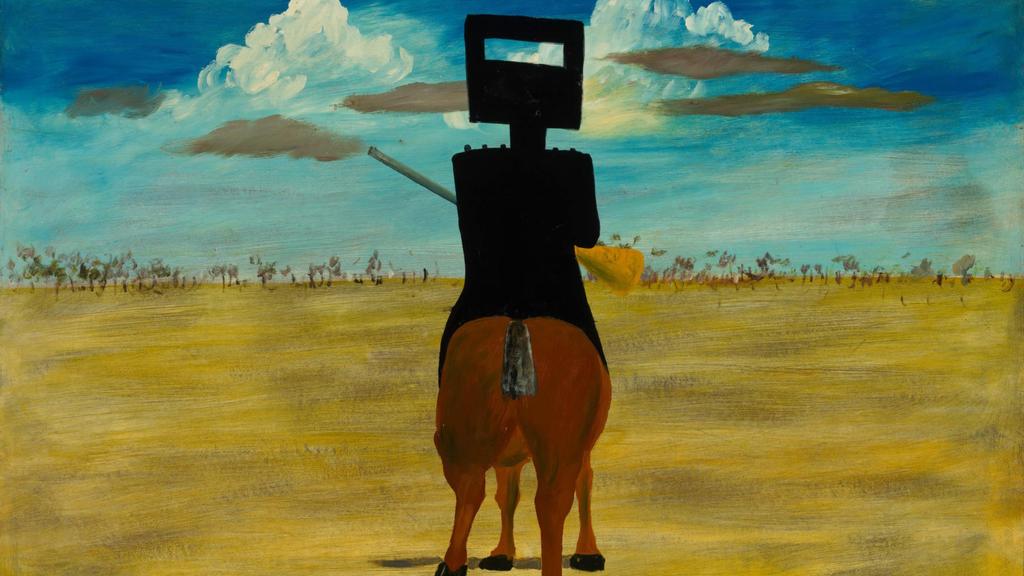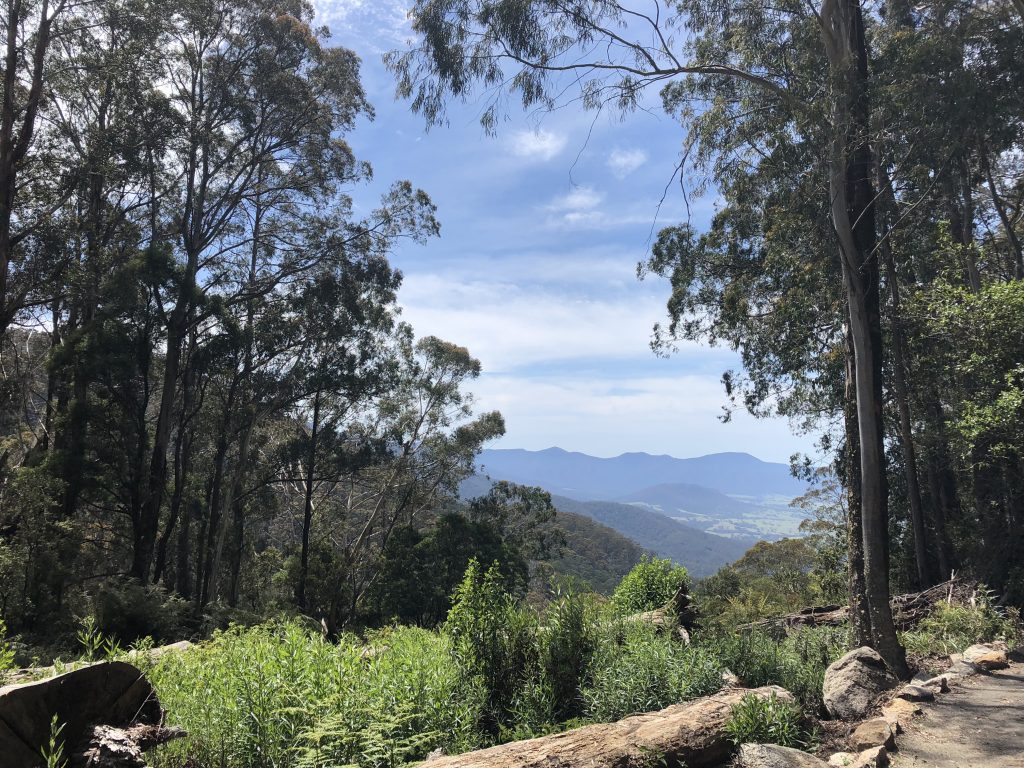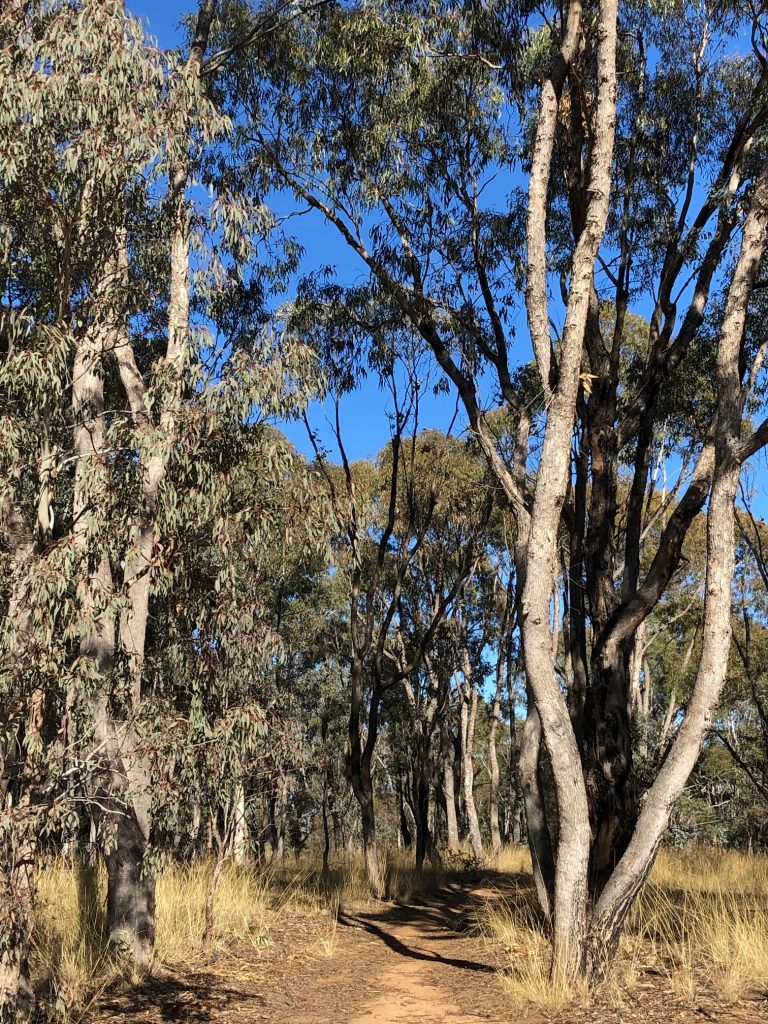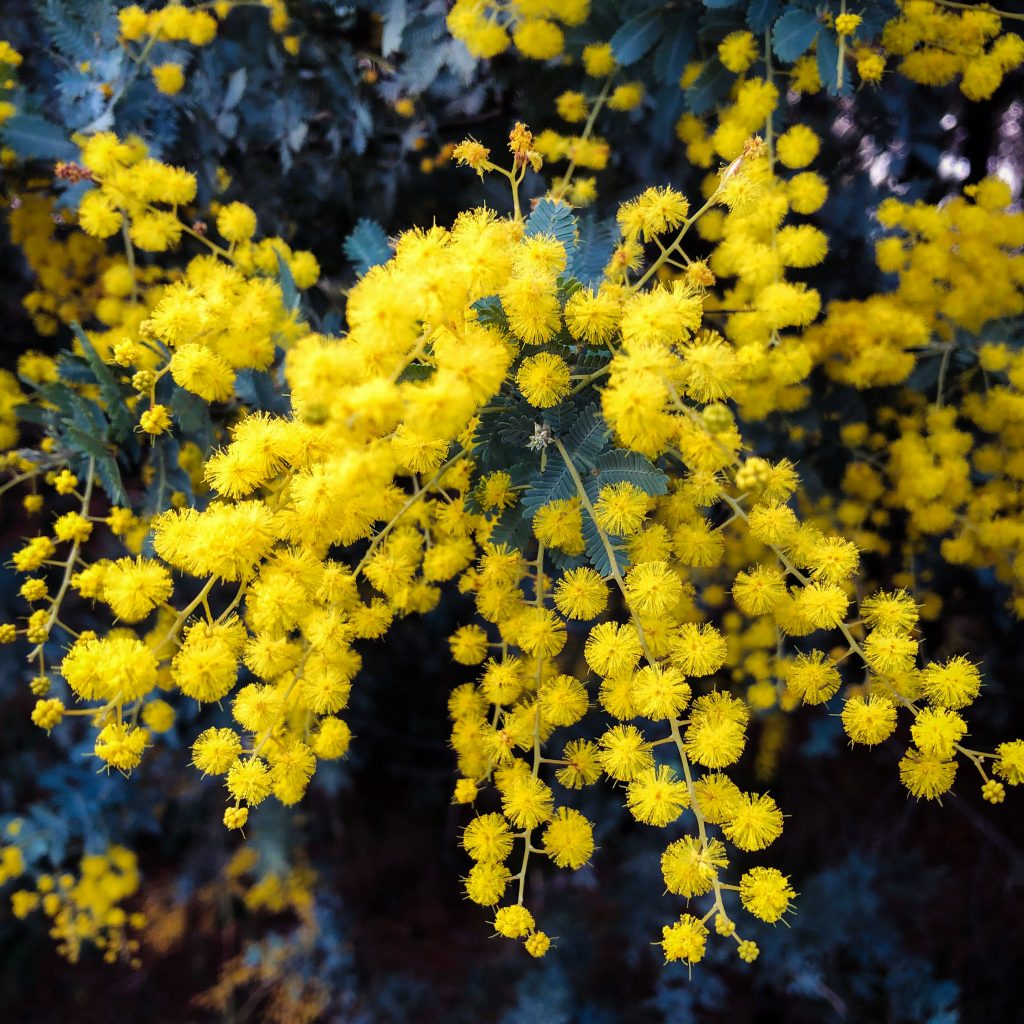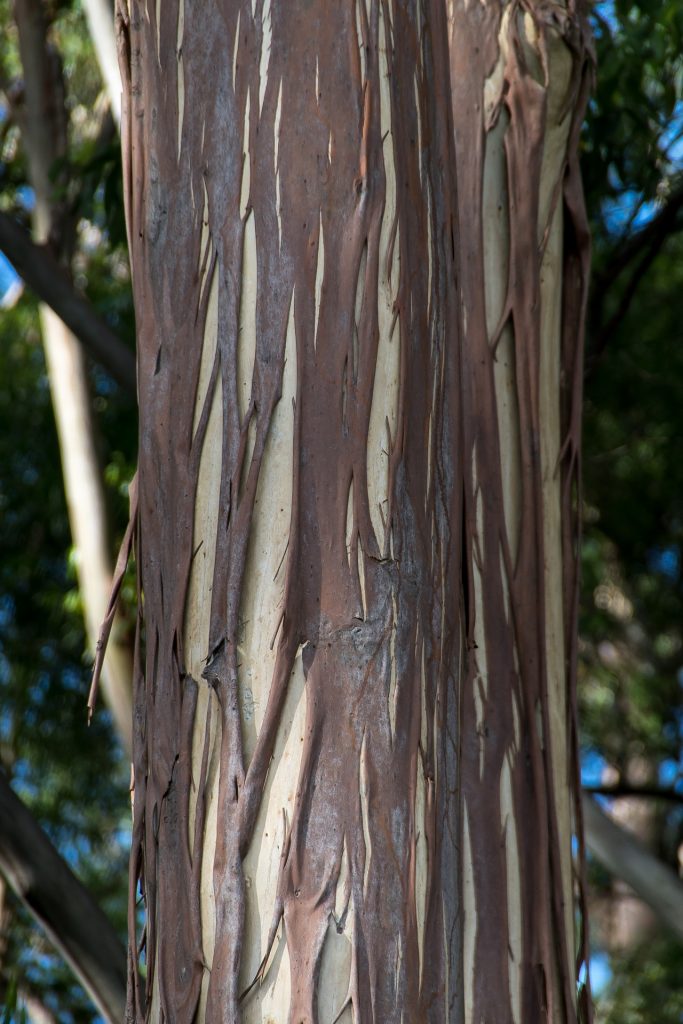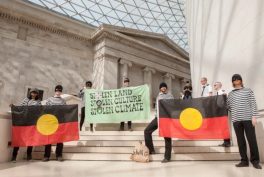Summary
- Australian art origins – Aboriginal art.
- The emergence of colonial European influences.
- Natural scenery from bush to coast as inspiration.
- Drawing from natural elements e.g. native flora.
- Classic Australian Impressionists to modern and commercial applications.
Not only does Australia boast world-class, national and state-based galleries, and art museums, it has a feast of regional art centers, thriving artistic festivals, and long art history. So, let’s dissect some of Australia’s artistic influences through common themes represented by popular artists. These themes often draw on inspirations from unique landscapes.
Art Origins in the Wide Brown Land
Understanding the beginnings of Australian art with just a micro-dose of history may help to understand the emergence of these themes. It would be remiss to discuss Australian art without first looking at its roots. The art of Australia’s First Nations people spans centuries with the first recorded rock art created an estimated 20,000 years ago. Pieces utilizing natural fibers and even body painting were also part of cultural artistry and ritual. Symbolism factored high in art as a means of storytelling and historical reference and has continued to be important to Aboriginal peoples and their culture.
Only in the more recent 20th century did techniques on cloth and canvas arise that would be recognized as modern representations of this art and culture. Early painters emerged during colonial times, such as the acclaimed Albert Namatjira (1902-1959), an Arrernte painter who learned western-influenced techniques to largely depict Central Australian landscapes. However, the most iconic style of Australian Indigenous art – often colloquially referred to as “dot paintings” – is considered to have taken off as an art movement during the 1970s, and has since held its place in tradition and profile. It spawned the Papunya Tula Artists Cooperative, established in 1972, and led to highly distinguishable techniques and styles that are arguably some of the most uniquely recognizable in the world. You may be familiar with the vibrant and earthy colored patterns achieved by applying precisely placed dots, curled strokes, lines, and symbols. They convey stories about nature, heritage, and community. They have also been used in a rich history of storytelling about spiritual beliefs and folklore including the Dreamtime.
Today, Aboriginal art is routinely discussed as a part of Australian school curriculum for history and culture. Visually striking pieces can be found in Australian galleries across all states and territories, and more locally as sold directly by individuals. While this level of exposure and commerce is great, it often – as is the case for many First Nations people internationally – presents a challenge in terms of identifying authenticity, and also ensuring credit and monetary benefits flow to the artists.
The collocation to this side of art history is in the white colonial past. When the British Empire arrived in Australia, they brought with them European influences on art. Australian art from the 18th century to the late 19th century progressed from topographical, Realist styles through to Impressionism and Art Nouveau.
By the 1900s, artists were finding their own unique ways to represent dramatized elements of Australia’s history, peoples, and landscapes, such as Sidney Nolan (1917-1992) and his conversation-provoking paintings depicting Australian bushrangers as modern folklore.
Like most colonial nations, Australia now questions the relevance and accuracy of much of its past, and it will be interesting to see how moral and ethical adjustments to thinking impact the viewing and understanding of pre- and post-colonial works. This is a lengthier and more complex discussion. With history and politics aside, let’s pay attention to some of the thematic inspirations Australian artists drew from.
Regardless of the style or the time, the thing that rings true is that Australia has an absolute abundance of natural inspiration to serve as fodder for art. Put simply, Australian artists have a preoccupation with trees and grass, surf and sand. Perhaps because there’s just so much of it.
Quintessential Themes from Nature
This discussion examines natural themes that homogenize as collective inspirations from Australian places. The seemingly common threads of identity that bridge from land to sea. Artists, craftspeople, and designers, both professional and amateur, draw from them constantly.
The Bush and Sweeping Plains
You cannot know Australian art without thinking of countless depictions of the Australian bush. “The bush” essentially is reference to the Australian natural landscape of trees with surrounding grasslands. Many might correlate it with references to wilderness, the woods, or “The Outback” (though for locals, this latter term more specifically conjures more remote areas of inland Australia, often devoid of many trees). In reality, the bush is all around in differences of scale – from the remotest regions to rural areas, along the coastlines, and surrounding almost all urban centers. It even encroaches comfortably into Australia’s larger cities. Its sheer abundance serves as inspiration for art.
Australia is indeed a “sunburnt country” and “wide brown land” as referenced in lines of the poem My Country by Dorothea Mackellar (1885-1968). Much of Australian landscape painting has conveyed this through scenes in muted browns, greens, and yellows to capture the wealth of eucalyptus trees, native scrub lands, arid hilly pastures, and grass plains. An often-cloudless, blue-sky scorches above, and at times a beige watering hole or river might break the dry. This is a land built to withstand fire and drought, and the shade of the eucalypts is welcomed in the heat of summer.
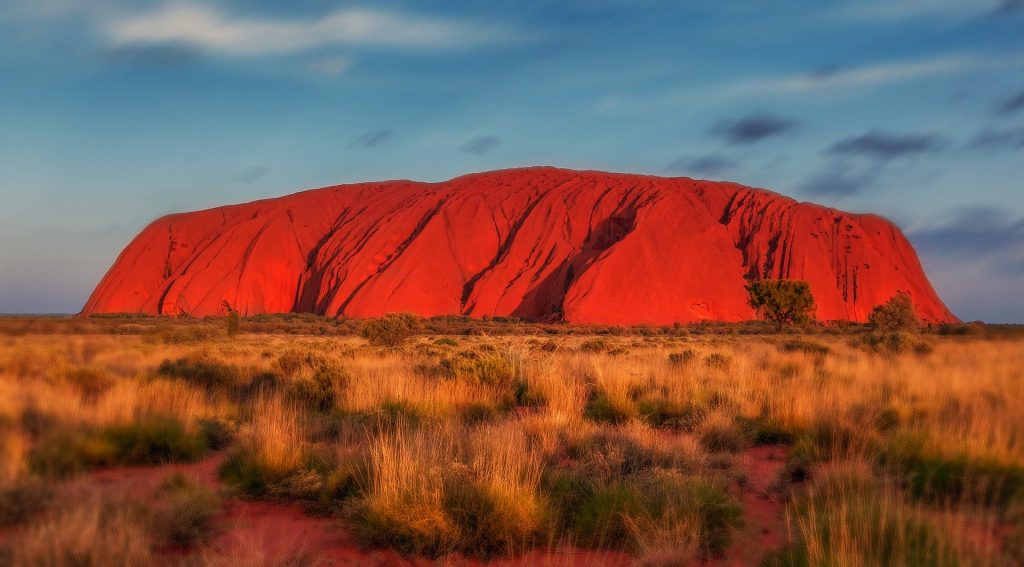
Uluru, Northern Territory, Australia. Pixabay.
While other inland scenes and more tropical northern landscapes serve as inspiration too e.g. the red center with its rust-colored soils and Uluru (the giant rock of topographical and cultural significance, in roughly “the middle” of the country), or the rainforests and coral reefs that deliver richer, wetter scenery, one could argue that the Australian bushland is still the most highly depicted theme of Australian art. Perhaps due to the sheer availability of references – an artist need only step outside any slightly less populous center to see it “right there”.
Starting with Tom Roberts (1856-1931), who as an immigrant led the Australian Impressionist movement known as the Heidelberg School, the journey of classical “bushland” landscapes solidified some of Australia’s best-known artists. Frederick McCubbin (1855-1917), one of the early Australian Impressionists, utilized bush landscapes paired with human figures to portray the early struggles of life on the land. Other revered artists such as Arthur Streeton (1867-1943), Elioth Gruner (1882-1939), and Tom Roberts (1856-1931) all used elements of the bush to represent Australian pastoral life.
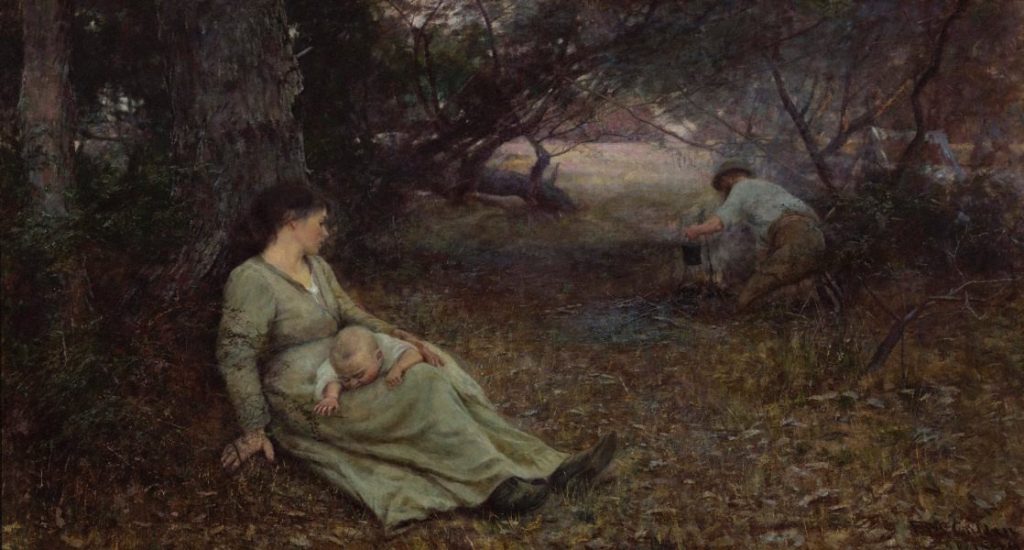
Frederick McCubbin, On the Wallaby Track, 1896, Art Gallery of New South Wales, Sydney, Australia.
The aforementioned Albert Namatjira’s use of watercolor and pencil to detail gum trees exemplifies this theme in which the focal point is often a bush element – a tree or a plant in the foreground – with rocky outcrops, a field, or a watering hole beyond. The focus on eucalypts is central to the theme – the gnarl of a single section of darker bark against a smooth, white snow gum trunk, or the many streaks of red, brown, and grey on a stringy bark tree, or the textured sooty blacks of an iron bark gum.
From the famous Arthur Boyd’s (1862-1940) more abstract and lyrical reverence to bush themes, to Russel Drysdale’s (1912-1981) Surrealist and stark representation of bush elements to convey mood, the bush has been depicted at large in many styles. It has also been shown up close, as with Nancy Borlase’s (1914-2006) colorful, abstract depictions of leaves and stones. Margaret Preston (1875–1963) was a painter and printmaker who turned bush themes into bright still lifes with her capture of Australian flora, snatched from the bush and arranged in vases – textured bottlebrush, lumpy banksia, and bright native flowers. Australian illustrator and acclaimed artist May Gibbs (1877-1969) took the concept of bush elements up-close to another level, commercializing the artistry of flora in often cartoony yet detailed watercolors with yellow wattle sprigs and green gumnuts. Best known as a children’s illustrator, she added cherubic characters and animals that became beloved and continue to serve as vintage imagery in the popular domain.
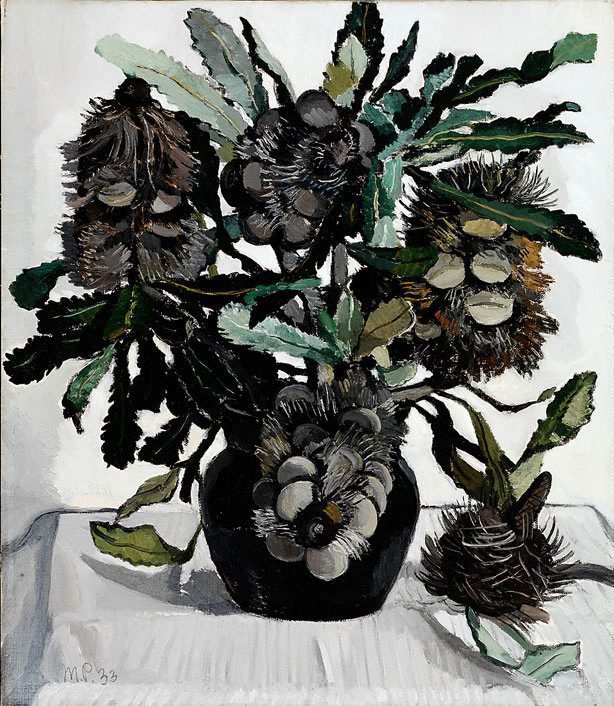
Margaret Preston, Banksia Cobbs, 1933, Art Gallery of New South Wales, Sydney, Australia.
There is no shortage of craggy bushland, sweeping fields, and native flora in Australia’s historical works, and it will continue to serve as inspiration for artists now and into the future.
Surrounding Seas and Sands
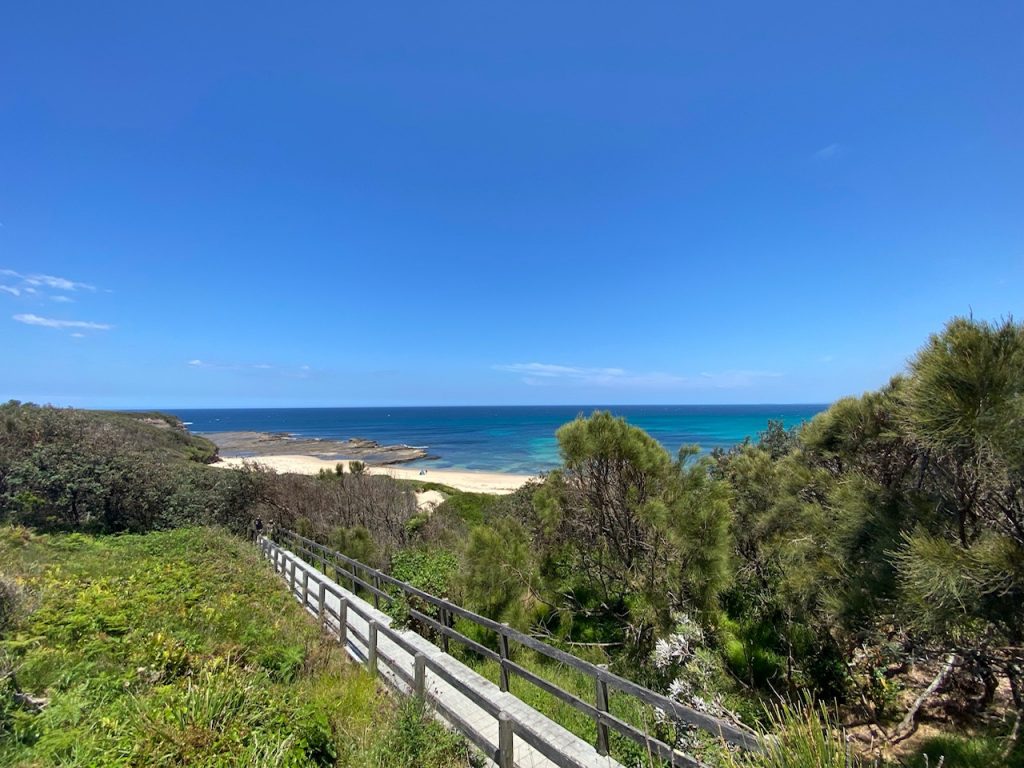
Renny’s Beach, Ulladulla, Australia, 2022. Photo by the author.
As an island nation and continent, Australia is surrounded by over 21,000 miles of coastline on all sides. Its major cities and regional hubs tend to hug these coastlines. The ever-changing ocean-scape and coastal eco-systems are again fodder for art. But what tells one sea painting from the next if it is merely an expanse of blue and white caps against a horizon? What makes it uniquely Australian? A walk through the National Gallery of Australia will turn out more Australian inland landscapes than seascapes, perhaps for this reason. Those seascapes depicted in classical art are often colonial in nature – historical showcases of ships arriving onshore. Aside from these, famous artists seemed to more readily paint the land as a reference to agricultural lifestyles, and in honor of urban growth – land was where the action and people were.
So what of Australian beach culture? Early works from the likes of Albert Hanson (1867-1914) captured some of the rugged beauty of Australia’s coastlines – with rocky coves, white sands, and surrounding bushland. An artist named Lloyd Rees (1895-1988) brought something different to the usual oil and acrylic fare with his experimental and moody sketches. Again, Elioth Gruner regards a mention for his several depictions of Australia’s famous Bondi Beach in Sydney’s surrounds e.g. Afternoon, Bondi (1915) – an oil painting of a young woman in the sand, clothed head to toe in white for modesty and apparent sun smarts.
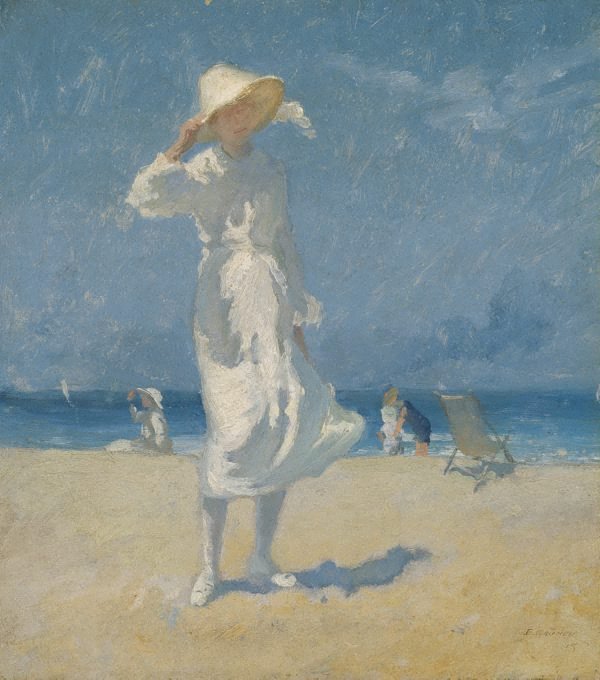
Elioth Gruner, Afternoon Bondi, 1915, Art Gallery of New South Wales, Sydney, Australia.
Charles Meere’s Beach Pattern (1940) goes some way to capture the great Australian beach pastime. A modernist oil painting of frivolity and action on the shores – men, women, and children having fun. Australian pop-modernist Peter Powditch captured more of this in a linear and direct fashion with works of acrylic on wooden board, such as Seascape II (1969), and Ken Done – one of Australia’s best-known living artists – became a modern proponent of beach design (among his other subjects) with his vibrant homage to seasides complete with swimmers, yachts, seagulls, and other nods to beachside living.
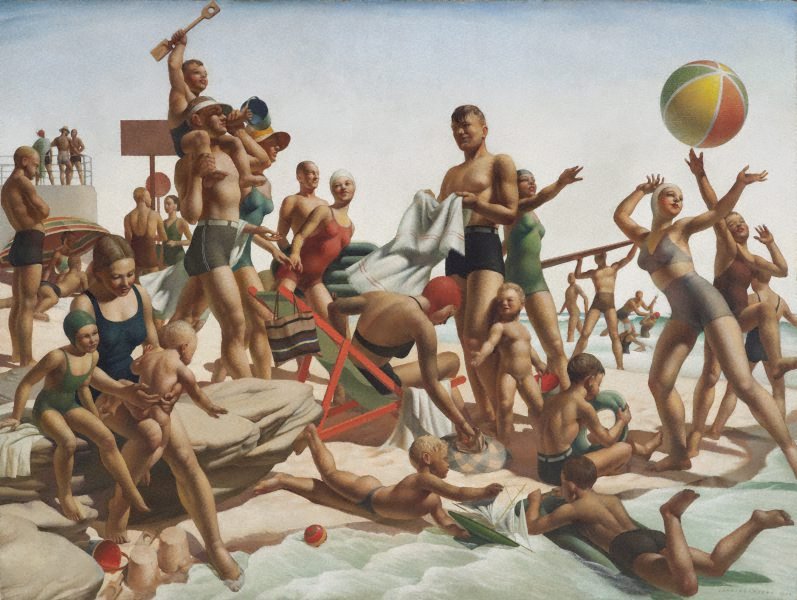
Charles Meere, Beach Pattern, 1940, Art Gallery of New South Wales, Sydney, Australia.
And if you are not convinced of Australia’s preoccupation with the beach and sea as fodder for art, look no further than the controversial 1977 artwork of Christmas Surfing Santa, designed by Roger Roberts. The colorful cartoon was used on a circulated 15c postal stamp. It copped not only ardent criticism but also subsequently became cherished and iconic in its own right, and was recently commemorated with a reproduction 50 years post-date.
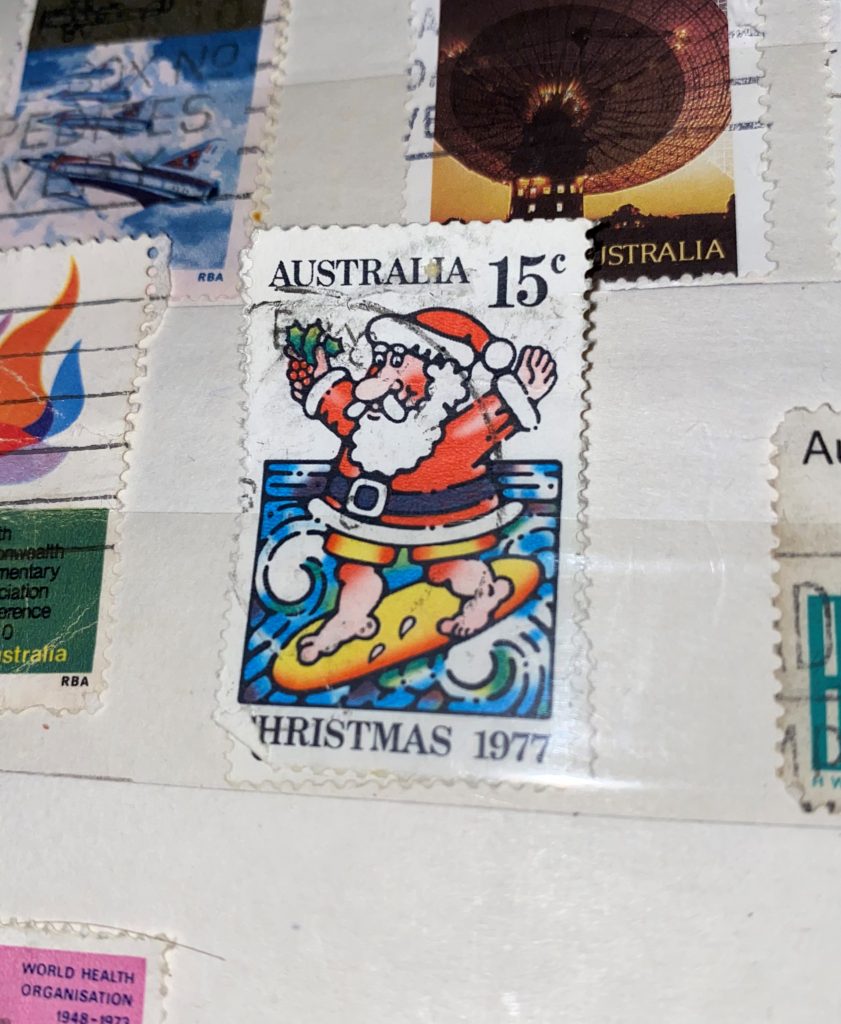
Roger Roberts, Christmas Surfing Santa, Australia Post, 1977. Photo by the author.
Modern coastal artworks prevail and have become one of the most common landscape themes in Australian regional galleries and art sales. Like the bush, it is possibly the sheer accessibility and contribution to Australian living that inspires art about the sea.
Nature is of course inherently beautiful, so we humans like to be in it, and to look at it. It is at once the muse and the art. So, it’s no big surprise that it features prominently in Australian art, just as it does in art from America, Europe, and the rest of the world. Yet I suppose there truly is something quite special in a simple Aussie gum tree, or a wave hitting some of the whitest sands in the world.
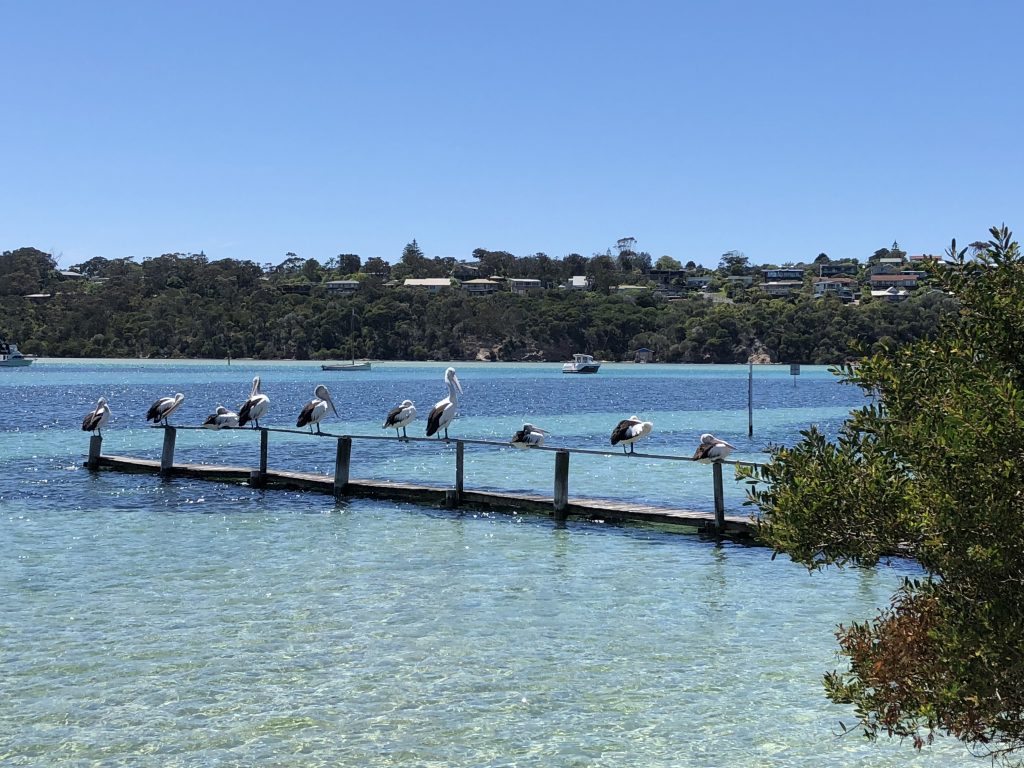
Bushland surrounds a residential area of a popular Australian tourist spot. South Coast, New South Wales, Australia. Photo by the author.
In the spirit of reconciliation, the Author wishes to acknowledge the Traditional Custodians of the country throughout Australia and their connections to land, sea, and community. To pay respects to their Elders past and present, and respects to Aboriginal and Torres Strait Islander peoples from diverse nations today.
The Author was saddened to learn that one of the artists mentioned in this article, Peter Powditch, passed away this week, aged 79. His contribution to the Australian art scene through his paintings, lithographs and sculptures will be remembered.
Author’s bio
Enita Hampton Donnelly is a professional writer based in Canberra Australia. Experienced ghostwriter for CEOs and Academics on topics of mental health, wellbeing, education and philanthropy. Her passions are creative writing
and art. She lives for her family, garden, pets, rainy days and coffee. See her self-proclaimed “bad art” on Instagram.
